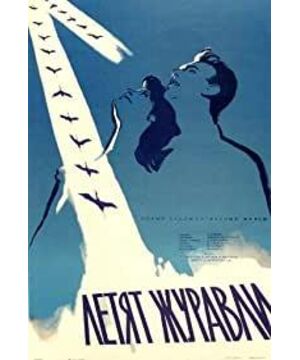1. In such a cruel local battle, more than 20 million Soviets died directly on the battlefield of World War II. That kind of pain, that kind of cultural memory that is still bleeding and unable to heal, is a highly internal reason that makes films like "Goose Nanfei" have such a strong, fresh and charming appeal.
2. A specific history creates a specific moment. In a scene similar to the New Wave, a group of Soviet directors who have experienced war and grew up in the war entered the film world, bringing us a number of historical masterpieces that are difficult to reproduce, and it is also a historical moment that is difficult to reproduce.
Today I would like to share with you a film from the former Soviet Union, which is also one of the most reputable films of the former Soviet Union-"Goose Nanfei". The film was made in 1957, which is a very special year in world political history. In 1956, Khrushchev became the supreme leader of the CPSU and published a long report called "Secret Report" at the 20th National Congress of the CPSU, which revealed a large number of atrocities in the Stalin era. The Soviet Union was the heaven of socialism, and the myth of socialism was exposed from the inside, exposed to its ugliness, and was torn apart as a result.
We are not going to discuss the huge impact this event has caused worldwide and the earthquake-like collapse caused by the socialist camp and the global left-wing camp. We are just discussing the occurrence of such a political transition in Soviet movies and Soviet literature and art. There has been a period called "thawing". Before the sacred laws of socialism began to be questioned, the long-standing Soviet film art began to appear in a brand-new face, and a generation of new filmmakers appeared on the film scene, and their debut became the most eye-catching feature of the film "Thaw." Phenomenon.
In fact, if we can temporarily put aside the Cold War era, the life-and-death confrontation at both ends of the Cold War boundary, we can also call the "Thawing" movie the new wave of Soviet cinema, and continue it to a series of new wave of movies after the war. In the middle. Because it, like all the new wave of movies, contains two important components: on the one hand, a new generation of newcomers, a group of new directors enter the movie stage as a whole; and on the other side, not only newcomers, not only Newcomers came on stage, but a new generation of newcomers brought a revolution in film aesthetics. It refreshed the face of film as a whole, and changed the film style, film narrative, and film language that had been gradually rigid in the studio systems of different countries. .
Of course, the cold war boundary still existed harshly in that era. This is not a fact that can be simply put on hold. However, "Unfreeze" movies have also become a film aesthetic revolution within Soviet film history, and the works created by this film aesthetic revolution have also overflowed the Soviet Union. For example, Chinese filmmakers at the time had watched these films—— Although many were viewed as critical objects or critical materials, in a sense, these films became ideal film models in the memory of the "fourth-generation directors" later called. It produced a kind of worldwide dissemination with the banner of humanitarianism and lyrical film aesthetics, and formed a very important inspiration and example for the fourth generation of directors who only appeared on the Chinese screen at the turn of the 1970s and 1980s.
"Goose Flying to the South" is a movie about a heartbreaking love story during World War II. It seems that the theme of the film is quite old, nothing more than war and peace, nothing more than people in war, nothing more than the destruction of human emotions, especially love and lovers, by war. So if I use a very vulgar imagination, I might use the name of a novel by García Márquez to translate it as "love in the spread of war." It is a love in a war period. All the themes are very old, but I will quote that sentence again and again-since Shakespeare, all the plots have been broken, but in the absence of new stories, there will always be fresh Lips. We always have fresh ways of telling that make old stories have a completely different meaning.
Although it has been so long, despite the many historical gaps and historical gaps between the Cold War, the post-Cold War, and the post-Cold War, I believe that friends who love movies will still be moved by this film. It is a very fascinating movie, a beautiful love story full of sadness, full of pain, full of not artificial but true, sad, or a beautiful love story written in a movie. Prose poems.
Why did it cause such an expression? Why has a very old story not become an old story? Why can a very old subject still be handled so powerfully? In my opinion, the so-called fresh lips is not an abstract imagination. Every time an old story will be refilled with still fresh historical experience, especially when this historical experience is a skin-cut, bloody wound. That experience was very different when it was time.
This extends to the Soviet movie. Although it has become extinct due to the disintegration of the Soviet Union and will no longer continue, the Soviet movie leaves us with a huge and precious film sequence. This film sequence is about war. In other words, World War II is a historical record of one of the worst wars in the history of human civilization that was once called the Patriotic War by the Soviets. Soviet writers and filmmakers once left us a very famous saying called "live and remember". Lenin, the political leader of the Soviet Union, once said a very famous saying, "Forgetting the past means betrayal." The two sentences are connected to each other but are not completely equivalent in semantics.
"Live and remember", it directly engraves the most painful historical will of the Soviets who experienced World War II. It is a historical testament passed down from generation to generation, so Soviet filmmakers over three generations have used audiovisual language to describe the Patriotic War in different ways, angles, and experiences. The Soviet Union was one of the most tragic battlefields during World War II because only this country was completely trapped in a state of domestic warfare, and it stubbornly resisted the Nazi German attack in a situation where it was almost impossible to resist, thus turning the European battlefield of World War II as a whole. The battle. In such a cruel local battle, more than 20 million Soviets died directly on the battlefield of World War II. That kind of pain, that kind of cultural memory that is still bleeding and unable to heal, is a highly internal reason that makes films like "Goose Nanfei" have such a strong, fresh and charming appeal.
The debut of the "Thaw" period and the most representative work of the "Thaw" period is Tarkovsky's "Ivan's Childhood". From the perspective of film history and Soviet cultural history, they can be regarded as the second generation of writing war memories, and the epic way of recording the Patriotic War is very different from the first generation. Because those movies are still full of the political requirements of socialism and realism, the ideology of socialism and realism, and the heroic view of socialism and realism.
And in this movie we saw a pair of lovers, we saw a pair of ordinary Soviet youths, we saw their years of love in the peace before the war, as beautiful as all love and all true love, The time of love, and we then saw the outbreak of war. Too many comments have mentioned those examples. When the sprinkler was passing by, the couple who fell in love did not even realize that the sprinkler was passing by. After that, the heroine seemed to be drenched in a rainstorm.
A lot of discussions have already talked about the delicate use of light and shadow, light and darkness, and the turbulence caused by the changing light and shadow to describe the innermost feelings of the characters in the Soviet film tradition, to outline the most subtle emotions and Show or predict the development of the plot. In this famous sprinkler scene, it consciously allows the hero Boris to stay in the shadows, and at the most beautiful and most addictive moment has heralded a gloomy future or a gloomy prospect.
It is also about war and peace. We may have almost infinite choices to describe it, and we may also deal with it with extremely opposed values. The war story of the "thawing" period, or the most important recurrence of the Great Patriotic War movie Change is the theme of humanitarianism. The value of life and the questioning of the value of life overwhelm heroism and become the most important theme. This is one reason why in the 1960s it had a great appeal and great influence on the generation of Chinese filmmakers who will be on the Chinese stage in the future.
In this sense, the most important plot structure in the movie is also the most important and colorful movie passage is the death of the hero Boris. It is also death in war. Different treatments will give it a completely different display. If we treat it as a battle against the enemy or even Huang Jiguang and Dong Cunrui’s style of changing the battle situation with one’s own life and one’s own body, death It becomes an affirmation of a just war, and an expression of value and value realization called death right. In this film, Paulis was hit by a stray bullet and died in an extraordinary situation of war under completely meaningless circumstances. This in itself has constituted an important significance of plot selection.
But what is repeatedly cited and praised by people is not at the level of plot narrative, but when Boris was shot and fell, and then a scene constructed by the director. We named it in the critical article of the organization as "Spinning the Earth-Spinning Camera Movement". Boris fell slowly during high-speed photography, that is, slow motion, and his life was quietly lost in this way. The camera was three hundred At a uniform speed of sixty degrees, it began to rotate highly poetically at the same time. During the rotation, the camera rose. It originally used Boris' subjective point of view lens to photograph the jungle, big trees and canopy in the eyes of this man who fell on his back at the moment of dying. , But very wonderful or full of sad poetry is this 360-degree panning of the jungle, tall trees, and canopy of the lens montage style, smooth transition should be Boris at the end of life. A final dream-this panning shot is transformed into a spiral staircase, a building formed by a highly styling, seemingly imaginative spiral staircase. In the subjective lens of the imagination, Boris holds his beloved The woman, the heroine in the wedding dress, walked to the wedding chapel.
It just used such a special film language, an ultra-conventional film movement method, and the visual language of montage created by Soviet films to form a life and death, tragedy and comedy, happiness and destruction in opposition. The integration in the continuous lens language space, so it forms a stronger, fuller and more unique expression than defending peace and accusing war in our usual sense.
In fact, the movie "Goose Flying to the South" became one of the few works in the entire Cold War era. It crossed the Cold War boundary. It won the Palme d’Or at the Cannes Film Festival that year and became the so-called Eastern world or the Eastern camp recognized by Western cinema. Of a movie.
The revolving camera movement is so compelling, so until the turn of the 1970s and 1980s, when the fourth generation of Chinese directors appeared on stage, they were constantly looking for opportunities to make the camera rotation and rotation of more than 180 degrees. In sports, I have always wanted to have the opportunity to reproduce that magical moment, using the language of a movie lens such as a peculiar extreme encounter to express life and death, love and destruction, war and peace.
The film not only chooses Boris's unnecessary death or worthless death on the plot level, but also chooses a theme that is close to betrayal on the side of Veronica, the heroine.
Regarding the Great Patriotic War, young friends may not be so familiar with it. My older generations and I grew up in the soaking and feeding of this culture. We are very familiar with the former Soviet Union and the entire Russian culture. The tradition of art and a wide variety of works. Regarding the Great Patriotic War, there have been many Soviet music, Soviet films, and literary works. One of the central and eye-catching images is a loyal and waiting woman. When men go to war, when men go to revolution, when men are exiled, how do those loyal wives wait and wait.
And another unique treatment point of "Goose Nanfei" is that it reverses this theme, and retells this theme in a reversed way. People who were so affectionate in love were separated by the outbreak of war, then Veronica should be a loyal guardian. In fact, if we see the end of the film, when today’s seemingly old and simple ending still cannot bear tears, we will still know that Veronica is such a brave and loyal woman. However, in the plot, she "transferred love" and married someone else. Although this was such a forced and humiliating choice, she "snatched a life" after all.
There are three train farewell scenes in the film, two of which have Veronica. The first time she tried to catch the train that sent the soldiers out to say goodbye to Boris, of course she did not expect the general It was a farewell, and she was late. At this time, the camera takes a long-shot continuous panning to show us the relatives inside and outside the carriage who are about to be separated by the war. This scene has been mentioned repeatedly, and in fact has become a classic passage in the history of film. It tells us that the cruelty of war may not need to rely on the presentation of the high-cost battlefields flying through the blood. In "Goose Flying to the South", on such a railway station platform, the shots of the inside and outside of the train are enough. We have seen people say goodbye to their relatives in such different ways, some singing, dancing, crying, and some just holding hands to see tears, but such a forced separation, such a peaceful daily life. The scenes that were suddenly torn apart are full enough to accuse wars, and to let people in peaceful times recognize the existence of such a human brutality called "war".
In the last scene, Veronica, who has lost her loyal wife and loyal guardian status, still embraces flowers to greet Boris when the soldiers finally return to their hometown. Every audience knows that she can't get anything, but she still goes. After the crowd cleared and the lucky people welcomed their relatives and left, Veronica gave the flowers in her hand to those who had no relatives waiting. Or the people who have been reunited with their relatives, like giving her love, her waiting, her loyalty, and the least weak woman's prayer for peace and protection of peace.
Speaking of this, it is impossible not to talk about the night when Veronica was raped. That night is often seen as an example of the brilliant practice of the Soviet montage school's theory in the 1960s. Everyone noticed the environment of the war, the night of explosions, bombings, and the darkness after indoor power outages, the turbulence of light and shadow, this rapist is actually Boris’s cousin, the violence between relatives, let’s not repeat it before this. Various preparations have been made to express the darkness, violence and evil in that character's heart.
In this passage, it uses a powerful montage unique to Soviet movies to form a passage. This passage not only successfully shows us the environment of war and peace, but also at this moment it faces the theme of war and peace or Towards the theme of daily life and violent destruction is another step further. Because there is not only violence in wars, but also destruction in wars. In the depths of human nature, in the abyss of human nature, there may also be so much darkness and so much cruelty in daily life.
I remember the first time I watched this movie while sitting under the screen of the Film Archive, the more painful thing in my memory was not the raped night, but the moment when Veronica decided to live. Everyone remembers that she appeared at the wedding, other people’s weddings instead of her and Boris’s wedding, the whole stiff body language, the camera scheduling, the shooting angle and the picture together describe that kind of invisible and huge at the same time The existence of pain that is difficult to heal.
Regarding this film, many researchers and film critics will talk about the camera movement that we just mentioned, the spiral staircase and the love scene, the person in love that is very subtle and very accurate in the lyrical choice. The kind of body tension or desire tension.
When this film successfully and powerfully reproduced the unique montage aesthetics of Soviet films in the 1960s, we will also see another displacement that occurred at the same time as the transfer of the theme value, a displacement of aesthetic choice, expressed in lyrical expressions. Montage replaced the so-called juggling montage. In other words, using short shots in different time and space, which may be empty shots, or shots with characters, to complete a shot segment, so as to successfully convey a kind of emotion, it is the so-called lyrical montage. paragraph.
The juggling montage emphasizes the direct creation of meaning through the combination of lens and lens. The most typical is that Eisenstein used the scene of killing strikers in "Strike" to directly connect the scene of killing animals in the slaughterhouse to create a political expression of class oppression and class repressive massacre. Pudovkin's so-called poetic montage or lyrical montage emphasizes the use of lenses to form images similar to those in poems, so as to form a verse-like expression. In "Goose Nanfei", the use of such lyrical montage passages and the lyrical montage-style selection are almost a key or structural element of the film.
As a kind of Russian culture, the iconic image of Russian painting, Russian art, and Russian film is the white birch tree. In the story of "Goose Flying to the South", the birch tree is consciously overlapped with the image of Veronica to a large extent, the poignant beauty, the luxuriant vitality that once existed, and at the same time there is a certain slenderness, a certain kind of luxuriant vitality. The beauty that is difficult to replace. For Chinese movie audiences and Chinese filmmakers, a film that has probably formed a deep memory imprint is called "The Dawn Here is Quiet". Friends who have watched this movie will remember the scene of the birch tree, the female warrior and the bathroom. Such a variety of expressions about youth, body, life, and desire, and these become cruel poetry when placed in a war environment.
In the meaning of the death of Boris, the betrayed Veronica, war and peace, and the so-called inner and peaceful depths of peace, this film overflows and breaks away from the original Soviet socialism and realism. The context shows a face to humanity, but at the same time still has an obsession with life, peace, and people who refuse to give up. It has such a conviction-style power to refuse to give up. This is probably one of the most important features of "Unfreeze" movies: accuse of war, and face people at the same time. This is the most powerful part of Russian culture that we often talk about, or Russian mythology almost has a kind of charm in my own words called disease, because it is so deep, it is so painful, it is so severe and so. It has the depth of philosophy and the power of philosophy. If you use the words of the important Soviet writer Gorky at the time, it is called "The charm of Russian culture lies in the courage to face the abyss, not only to face the abyss, but also to face the abyss without being dizzy."
"Goose Flying to the South" probably cannot be elevated to such a height that faces the abyss without fainting, but it is a reflection of such a spirit, it is such a kind of facing history directly, at the same time facing history directly The humanity in the middle is not trapped by one's own wounds, not intimidated by wounds that are still bleeding, not afraid of such a fact of facing the abyss, and continuously questioning people, life, and society.
A specific history creates a specific moment. In a scene similar to the New Wave, a group of Soviet directors who have experienced war and grew up in the war entered the film world, bringing us a number of historical masterpieces that are difficult to reproduce, and it is also a historical moment that is difficult to reproduce.
View more about The Cranes Are Flying reviews






